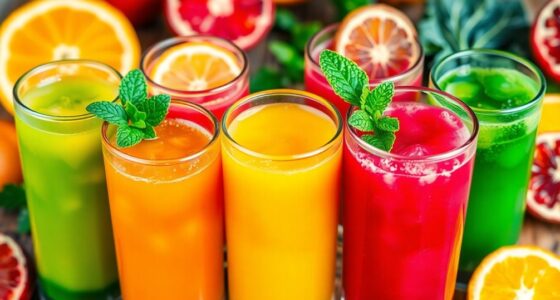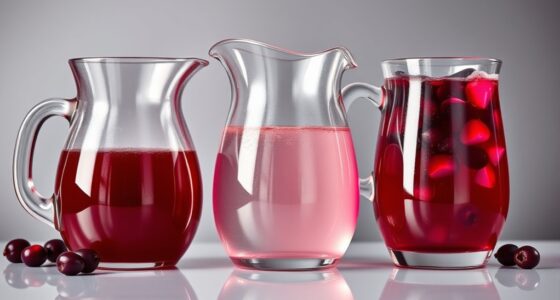Limes typically yield about 1 to 2 ounces of juice each, depending on their size and ripeness. If you're using medium limes, expect around 1 ounce per lime. To get a full cup of juice, you'll need about 8 limes. For the best yield, choose heavy, firm limes with smooth skin. By exploring further, you'll discover tips on selecting, zesting, and juicing limes to maximize that invigorating flavor in your dishes!
Key Takeaways
- A medium lime typically yields about 2 tablespoons, or 1 ounce, of juice.
- On average, 1 to 2 ounces of juice can be extracted from a single lime.
- Approximately 8 limes are required to produce 1 cup of lime juice.
- A pound of limes, containing 4 to 5 medium limes, yields about 1/2 to 2/3 cup of juice.
- Juice yield varies based on lime size and ripeness, with ripe limes producing more juice.
Juice Yield From Limes
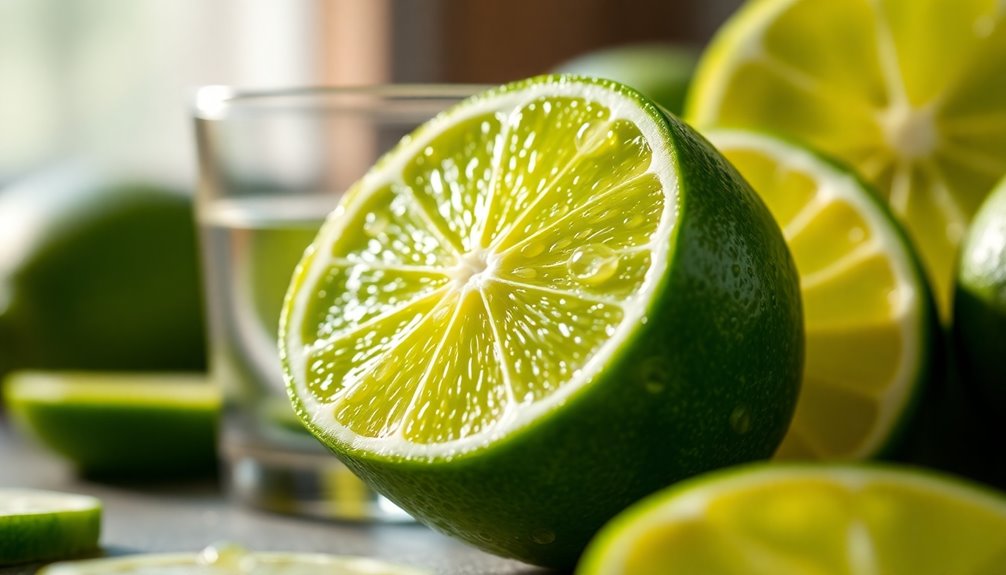
When you're juicing limes, you can expect each medium lime to yield about 2 tablespoons, or 1 ounce, of juice. If you need a cup of lime juice, you'll want to grab approximately 8 limes.
For smaller recipes, a half lime will give you roughly 1 tablespoon of fresh lime juice, making it easy to measure. Keep in mind that the juice yield may vary slightly based on the lime's ripeness and size, but generally, you'll find consistency across different limes.
Typically, a pound of limes contains about 4 to 5 medium limes, yielding between 1/2 to 2/3 cup of juice. So, when you're at the cutting board, you'll know just how many limes you need!
Understanding Lime Zest

Juicing limes not only provides a revitalizing liquid for your recipes but also opens the door to another flavorful component: lime zest. This vibrant flavor booster can elevate your culinary preparations, adding an invigorating kick to both sweet and savory dishes.
Fresh lime zest, which contains aromatic oils, enhances flavor far better than dried alternatives. To extract zest, you can use various zesting techniques like a micro-plane, fine grater, or peeler, making it easy to incorporate into your cooking.
Plus, if you find yourself with extra zest, it can be frozen for later use, preserving its delightful flavor profile. So, don't overlook lime zest; it's a simple way to take your dishes to the next level!
Selecting the Right Lime

Selecting the right lime can greatly impact the juicing experience, so it's important to know what to look for.
When you're selecting limes, choose ones that feel heavy for their size; this usually means they'll yield more juice. Look for smooth, thin skins and avoid any with brown spots or indentations, as these may indicate overripeness.
Firm limes that yield slightly when squeezed are your best bet, since hard limes might be dry and lacking in juice. Always opt for greener Persian limes over yellow-green ones; they're typically fresher and juicier.
Tips for Juicing Limes Effectively
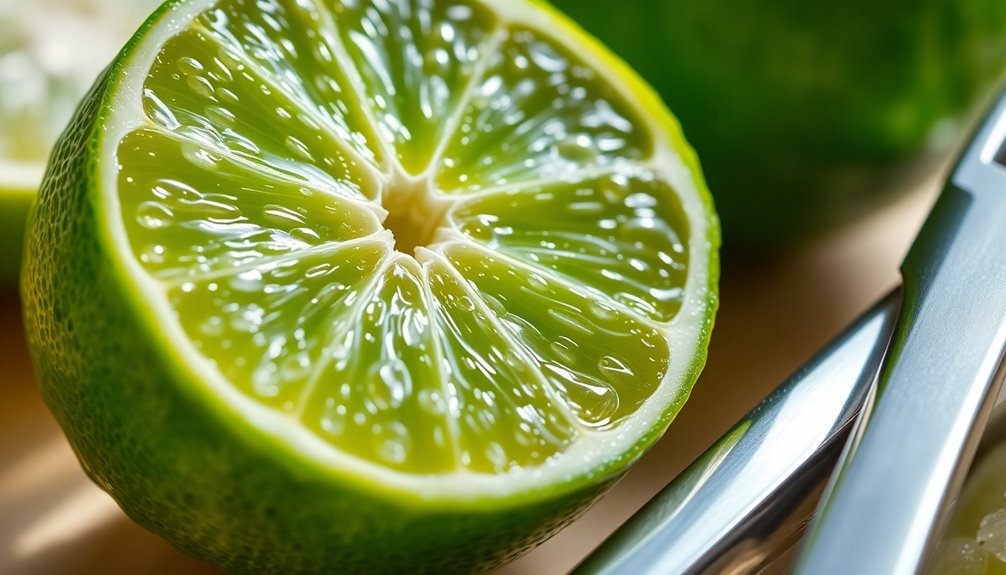
After you've picked the perfect limes, it's time to maximize their juice yield. Here are some tips to help you juice a lime effectively:
- Roll the lime on a countertop to break down internal membranes.
- Microwave limes for about 20 seconds to soften them.
- Cut limes into cheeks instead of halves for better juice extraction.
- Use a manual juicer or reamer for ideal lime yields.
- Collect fresh juice in a prep bowl to avoid spills and simplify measurement.
These methods are the best way to juice and can help you get the most tablespoons of juice from each lime.
Fresh vs. Bottled Lime Juice
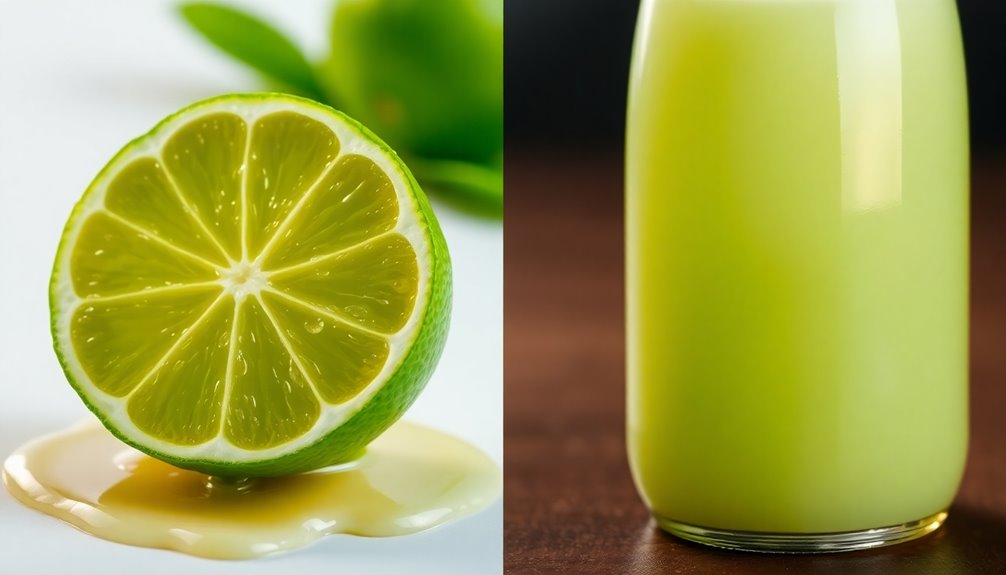
Fresh juice brings a vibrant, aromatic punch that bottled options just can't match, often due to pasteurization and preservatives. Plus, understanding the benefits of fresh juice and its shorter shelf life can help you make the best choice for your recipes. Additionally, fresh lime juice is packed with antioxidants that combat oxidative stress, which can enhance overall health.
Flavor Quality Difference
While you might reach for bottled lime juice for convenience, fresh lime juice offers a flavor profile that's simply unmatched. The difference in taste can greatly impact your cooking and baking.
Here's why you should choose fresh:
- Brighter, more dynamic flavor that elevates dishes
- Authentic taste with floral notes, especially in key limes
- Vibrant taste that enhances cocktails like margaritas and Moscow mules
- No preservatives or additives, ensuring pure flavor
- Better complexity for various culinary uses
- Fresh lime juice can also enhance dishes by adding a zesty kick that perfectly complements savory meals.
When you want to elevate flavor and truly enjoy your meals and drinks, fresh lime juice is the way to go.
Bottled varieties simply can't compete with that lively, fresh zing!
Fresh Juice Benefits
Choosing fresh lime juice over bottled options offers numerous benefits that can greatly enhance your culinary experience. Fresh lime juice from a medium lime yields about 1 ounce, providing a vibrant flavor that's essential for recipes like margaritas and guacamole. The dynamic flavor profile of freshly squeezed juice elevates the acidity, making your dishes pop. Additionally, the high fiber content in chia seeds can complement lime juice in health-conscious recipes.
| Feature | Fresh Lime Juice | Bottled Lime Juice |
|---|---|---|
| Flavor | Vibrant and dynamic | Flat and less aromatic |
| Freshness | High | Often pasteurized |
| Best for | Culinary dishes | Quick substitutes |
When you want to truly savor your dishes, always opt for fresh lime juice!
Storage and Shelf Life
Fresh lime juice typically lasts about a week in the refrigerator, making it essential to use it promptly for the best flavor.
In contrast, bottled lime juice has a longer shelf life due to preservatives, typically lasting several months once opened.
Here are some tips for storing both types:
- Keep fresh lime juice in the fridge for ideal freshness.
- Store bottled lime juice in a cool, dark place to maintain quality.
- Refrigerate opened bottled lime juice and use it within a few weeks.
- Always check the expiration date on bottled varieties.
- Discard any bottled juice that appears cloudy or smells off to avoid spoilage.
Choosing between fresh and bottled lime juice depends on your flavor preference and how soon you plan to use it!
Common Lime Substitutions
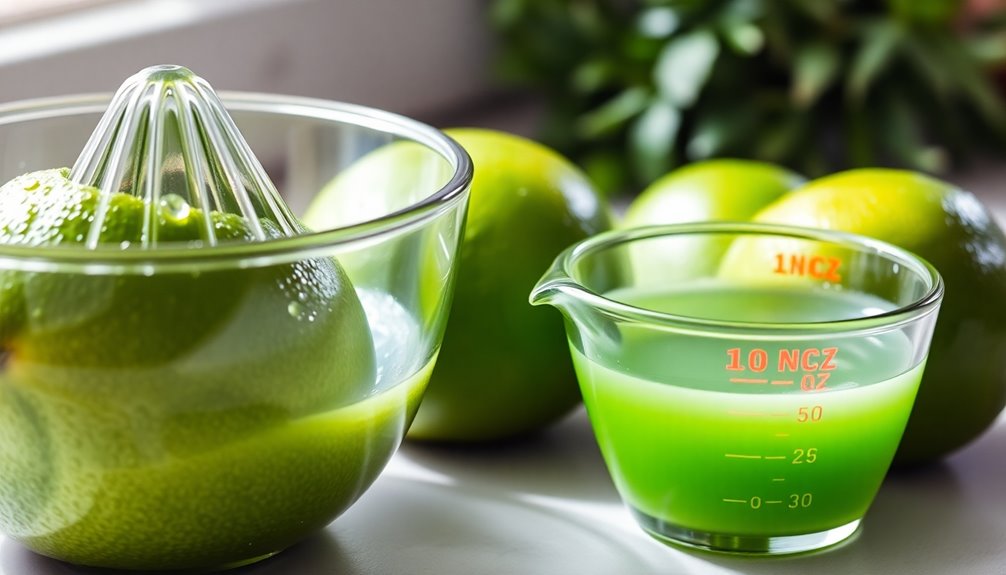
When you can't find fresh lime juice, there are several alternatives that work just as well in your recipes.
For instance, you can use lemon juice or even a bit of vinegar for that tangy kick.
Plus, don't forget that lime zest can add a burst of flavor if you're short on juice! Additionally, using low-fat ice cream as a refreshing treat can provide a delightful contrast to the acidity of lime in desserts.
Fresh Lime Juice Alternatives
Although fresh lime juice is often the go-to for its zesty flavor, there are several effective alternatives you can use when it's not available.
Here are some substitutes to evaluate:
- Bottled lime juice: Convenient but may taste flat due to pasteurization.
- Fresh lemon juice: A citrus fruit alternative that alters the flavor profile slightly.
- Mix of lemon and lime juice: Mimics Key lime juice; use 2 to 3 times less than required.
- Persian limes: Larger than Key limes, may need more for the same juice yield.
- Vinegar: Works in marinades or dressings, but lacks the citrusy aroma of lime.
These options can help keep your dishes vibrant and delicious!
Zest vs. Juice Substitution
How do you choose between zest and juice when cooking? Both lime zest and fresh lime juice enhance your dishes but serve different purposes. If a recipe calls for juice from one lime, remember that one lime typically yields about 2 tablespoons of juice.
Here's a quick guide for substituting:
| Ingredient | Substitution | Notes |
|---|---|---|
| Fresh Lime Juice | Bottled Lime Juice | Use same volume; taste may vary. |
| Lime Zest | Lemon Zest | Equal amounts; flavor differs. |
| Key Lime Juice | 2 parts Fresh Lime Juice + 1 part Lemon Juice | Use half the amount called for. |
When you need a substitute, use this guide to maintain flavor and aroma in your recipes. Additionally, incorporating fresh herbs can enhance the overall flavor profile of your dish, making it even more delightful.
Frequently Asked Questions
How Much Lime Juice Does One Lime Yield?
One medium lime typically yields about 2 tablespoons, or 1 ounce, of juice.
If you're using a half lime, expect around 1 tablespoon, or 0.5 ounces.
For larger recipes, remember that you'll need about 8 limes to get a cup of juice.
To maximize your yield, try rolling the lime on a countertop or microwaving it briefly before juicing.
This can help you extract every last drop of that flavorful juice!
How Many Oz Can You Get Out of a Lime?
Think of a lime as a treasure chest waiting to be revealed. When you cut one, you typically release about 1 ounce of juice.
If you're whipping up something special, you'll need about 2 limes for 1/4 cup of juice or 4 limes to fill a 1/2 cup.
Remember, the juice yield can vary a bit, but on average, you can expect about 1 ounce per medium lime. To maximize your juice yield, roll the lime on a hard surface before slicing it in half; this helps to break down the internal membranes. Additionally, the ripeness of the lime can influence the amount of juice extracted, with slightly overripe limes often producing more juice. For those looking for precise quantities in recipes, the lime juice measurement explained can help guide your expectations and ensure delicious results every time you cook or mix drinks.
Enjoy your culinary adventure!
How Much Concentrated Lime Juice Is in One Lime?
One medium lime typically gives you about 1 ounce, or 2 tablespoons, of concentrated lime juice.
Keep in mind that the amount can vary based on the lime's size and ripeness. If you're planning to make a recipe that needs more juice, you'll probably need around 8 limes to get a full cup.
To maximize juice extraction, try rolling the lime on the counter before cutting it. You'll get more juice that way!
Can I Substitute Bottled Lime Juice for Fresh Lime Juice?
Imagine a vibrant garden where fresh limes hang like jewels, bursting with flavor.
When you consider substituting bottled lime juice for fresh, remember that while the bottled version can save time, it often lacks that zesty brightness.
You'll want to use 2 to 3 times less bottled juice than fresh in your recipes.
Fresh lime juice brings a unique aroma and taste that bottled just can't match, especially in your favorite dishes.
Conclusion
In the end, knowing how much juice a lime can give you transforms your cooking, much like a small spark igniting a fire. A typical lime yields about 2 tablespoons of juice, which can brighten a dish or cocktail. So, the next time you squeeze a lime, think of it as releasing a burst of sunshine into your meal. With the right techniques, you'll always get the most out of those vibrant green gems!
Cindy thoroughly researches juicing trends, techniques, and recipes to provide readers with practical advice and inspiration. Her writing style is accessible, engaging, and designed to make complex concepts easy to understand. Cindy’s dedication to promoting the advantages of juicing shines through her work, empowering readers to make positive changes in their lives through the simple act of juicing.




